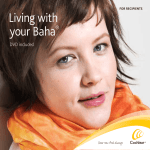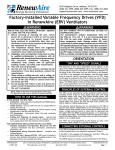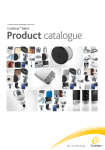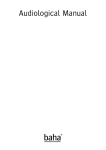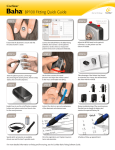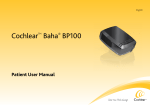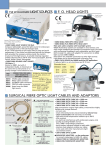Download Baha 3 Fitting Guide
Transcript
Sound Processors Fitting Quick Guide STEP 1 Ensure that the abutment is secure and that the area around it is clean. Connect the Baha® 3 Sound Processor (BP100 or BP110) to the Baha Fitting Software, then connect it to the patient’s abutment. Use BC Direct to measure the patient’s direct bone conduction thresholds. Have the patient practice connecting/disconnecting the dummy device, first on a snap trainer, then on his/her abutment. STEP 7 Volume up and down button Adjust the Baha 3 Sound Processor (BP100 or BP110) based on the patient’s comments. Let the patient reset the volume if needed. STEP 6 STEP 5 STEP 4 Baha 3 Sound Processor (BP100) STEP 3 STEP 2 Let the client connect the sound processor and adjust the volume control to the most comfortable level (MCL). STEP 8 Take advantage of the Patient User Manual to review the next 4 steps, this will familiarize the client with the manual. STEP 9 Baha 3 Power Sound Processor (BP110) Explain how to use the on/off button, program buttons and volume control and how to care for the sound processor. STEP 10 Specify which accessories are available; discuss uses and the client’s possible needs. Instruct the client on care and maintenance of the abutment and abutment area. STEP 11 Review troubleshooting of the sound processor. Describe how to change the battery and mention the expected battery life. STEP 12 Fill in the registration card. Explain insurance terms and warranties. Schedule a follow-up appointment. For more detailed information on fitting and fine tuning, see the Cochlear Baha Fitting Software Guide. ™ Sound Processors Fine Tuning Quick Guide For the best fitting of the Cochlear Baha 3 Sound Processors ensure that the bone conduction audiogram(s) are entered and the following steps are included in your fitting session: ™ ® STEP 1 STEP 2 BC SELECT BC DIRECT BC Select provides the opportunity to pre-set the sound processor to match your patient’s unique needs. Choose within these following parameters: BC Direct allows an accurate threshold measurement through the Baha 3 Sound Processor on the patient’s abutment or Softband or headband. Using these BC Direct thresholds, the Cochlear Baha Prescription method generates ˈˈ̎˫ ̐ ̎˨˨˫ ̐ ̭̭̎˫ ̐ ̎˨˫ STEP 3 STEP 4 HEARING MENTOR FINE TUNING Hearing Mentor allows global changes to the frequency response of the sound processor based on the patient’s comments about the sound quality, their own voice, loudness, and performance in noise. If you would like to manipulate the gain for the Baha 3 Sound Processor in each channel and for each input level (soft sound 40dB, loud sound 60dB ̕˫ ˫ NOTE: The instructions provided above are applicable to both Baha 3 (BP100) and Baha 3 Power (BP110) Programmable Sound Processors. www.CochlearAmericas.com Cochlear, Hear Now. And Always, and the elliptical logo are trademarks of Cochlear Limited. Baha is a registered trademark of Cochlear Bone Anchored Solutions AB. © 2012 Cochlear Bone Anchored Solutions. BUN080 ISS1 JAN12





